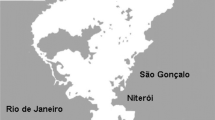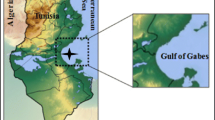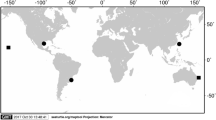Abstract
Recently, we found that liver of squirrelfish (Holocentrus rufus) from Bermuda contains remarkably high concentrations of metallothionein (MT) and Zn. To clarify the nature and cause of the Zn accumulation, four Holocentridae species from three genera (Neoniphon sammara, Sargocentron spiniferum, Myripristis violacea, and Myripristis murdjan) were collected from a totally different area, the Great Barrier Reef, Australia. The average hepatic Zn levels in these species ranged from 67 μg g-1 (S. spiniferum) to 1000 μg g-1 (N. sammara). The intraspecies variation in the hepatic Zn level was pronounced. In both N. sammara and M. murdjan, there was a 48-fold difference between the lowest and the highest Zn concentration. Zn accumulation was closely correlated to a dramatically elevated concentration of MT in liver. In N. sammara, which possessed the highest level of MT among the investigated species, the mean hepatic MT concentration was 19 500 μg g-1. Subcellular fractionation of the liver showed that MT was responsible for the binding of up to 74% of the hepatic Zn. The concentrations of MT and Zn in gills were low, suggesting that Zn storage in fish within this family is tissue-specific. The results further indicate that the high concentrations of MT and Zn in Holocentridae liver are linked to normal physiological processes. We suggest that the Holocentridae family may be a unique model for future studies of Zn metabolism and the function of MT.
Similar content being viewed by others
References
Benson WH, Birge WJ (1985) Heavy metal tolerance and metallothionein induction in fathead minnows: results from field and laboratory investigations. Envir Toxic Chem 4: 209–217
Brdicka R (1993) Polargraphic studies with the dropping mercury kathode. Part XXXI. A new test for proteins in the presence of cobalt salts in ammoniacal solutions of ammonium chloride. Coll Czech chem Commn Engl Edn 5: 112–128
Bremner I, Beattie JH (1990) Metallothionein and the trace minerals. A Rev Nutr 10: 63–83
Bryan GW (1976) Some aspects of heavy metal tolerance in aquatic organisms. In: Lockwood APM (ed) SEB Seminar Series. Cambridge University Press, Cambridge, London, pp 7–34
Bunton TE, Baksi SM, George SG, Frazier JM (1987) Abnormal hepatic copper storage in a teleost fish (Morone americana). Vet Path 24: 515–524
duPreez HH, Steyn GJ (1992) A preliminary investigation of the concentration of selected metals in the tissues and organs of the tigerfish (Hydrocynus vittatus) from the Olifants River, Kruger National Park, South Africa. Water SAfr 18: 131–135
Eckhert CD (1983) Elemental concentrations on ocular tissues of various species. Exp Eye Res 37: 639–647
George SG, Olsson P-E (1994) Metallothioneins as indicators of trace metal pollution. In: Kramer KJM (ed) Biomonitoring of coastal waters and estuarines. CRC Press, Boca Raton, Florida, pp 151–178
Goldfisher S, Schiller I, Sternlieb IB (1970) Copper in hepatocyte lysosomes of the toad, Bufo marinus L. Nature, Lond 228: 172–173
Goskowicz M, Eichenfield LF (1993) Cutaneous findings of nutritional deficiencies in children. Curr Opin Pediatr 5: 441–445
Hogstrand C, Haux C (1990) Metallothionein as an indicator of heavy-metal exposure in two subtropical fish species. J exp mar Biol Ecol 138: 69–84
Hogstrand C, Haux C (1991) Binding and detoxification of heavy metals in lower vertebrates with reference to metallothionein. Comp Biochem Physiol 100C: 137–141
Hogstrand C, Haux C (1992) Evaluation of differential pulse polarography for the quantification of metallothionein — A comparison with RIA. Analyt Biochem 200: 388–392
Hogstrand C, Lithner G, Haux C (1991) The importance of metallothionein for the accumulation of copper, zinc and cadmium in environmentally exposed perch, Perca fluviatilis. Pharmac Toxic 68: 492–501
Hogstrand C, Verbost PM, Wendelaar Bonga SE, Wood CM (1995) Mechanisms of zinc uptake in gills of freshwater rainbow trout: interplay with calcium transport. Am J Physiol (in press)
Hogstrand C, Wood CM (1995) The physiology and toxicology of zinc in fish. In: Taylor EW (ed) SEB seminar series — Aquatic toxicology. Cambridge University Press, Cambridge (in press)
Hylland K, Haux C, Hogstrand C (1992) Hepatic metallothionein and heavy metals in dab Limanda limanda from the German Bight. Mar Ecol Prog Ser 91: 89–96
Jickells TD, Knap AH (1984) The distribution and geochemistry of some trace metals in the Bermuda coastal environment. Estuar cstl Shelf Sci 18: 245–262
Johnson GF, Morell AG, Stockert RJ, Sternlieb I (1981) Hepatic lysosomal copper protein in dogs with an inherited copper toxicosis. Hepatol 1: 243–248
Menkes JH, Alter M, Steigleder GK, Weakley DR, Sung JH (1962) A sex-linked recessive disorder with growth retardation, peculiar hair, and focal cerebellar degeneration. Pediatrics 29: 764–779
Olafson RW, Olsson P-E (1991) Electrochemical detection of metallothionein. In: Riordan JF, Vallee BL (eds) Methods in enzymology. Metallobiochemistry. Part B. Metallothionein and related molecules. Academic Press, San Diego, pp 205–213
Olsson P-E, Förlin L, Haux C (1987) Variations in hepatic metallothionein, zinc and copper levels during an annual reproductive cycle in rainbow trout. Fish Physiol Biochem 3: 39–47
Olsson P-E, Haux C (1986) Increased hepatic metallothionein content correlates to cadmium accumulation in environmentally exposed perch (Perca fluviatilis). Aquat Toxic 9: 231–242
Olsson P-E, Hogstrand C (1987) Improved separation of perch liver metallothionein by fast protein liquid chromatography. J Chromatogr 402: 293–299
Olsson P-E, Larsson Å, Maage A, Haux C, Bonham K (1989) Induction of metallothionein synthesis in rainbow trout, Salmo gairdneri, during long-term exposure to waterborne cadmium. Fish Physiol Biochem 6: 221–229
Onosaka S, Cherian MG (1982) Comparison of metallothionein determination by polarographic and cadmium-saturation methods. Toxic appl Pharmac 63: 270–274
Overnell J, McIntosh R, Fletcher TC (1987) The levels of liver metallothionein and zinc in place, Pleuronectes platessa L., during the breeding season, and the effect of estradiol injection. J Fish Biol 30: 539–546
Sandström B, Cederblad A, Lindblad BS, Lönnerdal B (1994) Acrodermatitis enteropathica, zinc metabolism, copper status, and immune function. Arch pediatr adolesc Med 148: 980–985
Scheinberg IH, Sternlieb I (1965) Wilson's disease. A Rev Med 16: 119–134
Takeda H, Shimizu C (1982) Existence of the metallothinonein-like protein in various fish tissues. Bull Jap Soc scient Fish 48: 711–715
Thompson JAJ, Cosson RP (1984) An improved electrochemical method for the quantification of metallothioneins in marine organisms. Envir Res 11: 137–152
Vallee BL, Falchuk KH (1993) The biochemical basis of zinc physiology. Physiol Rev 73: 79–118
Van Wouwe JP, Uijlenbroek JJ (1994) The role of the pancreas in the regulation of zinc status. Biol trace Elem Res 42: 143–149
Waldrop GL, Ettinger MJ (1990) The relationship of excess copper accumulation by fibroblasts from bridled mouse model of Menkes disease to the primary defect. Biochem J 267: 417–422
Weitzel G, Strecker F-J, Roester U, Buddecke E, Fretzdorff A-M (1954) Zink im Tapetum lucidum. Hoppe-Seyler's Z physiol Chem 296: 19–30
Wicklund Glynn A, Haux C, Hogstrand C (1992) Chronic toxicity and metabolism of cadmium and zinc in juvenile minnows (Phoxinus phoxinus) exposed to a cadmium and zinc mixture. Can J Fish aquat Sciences 49: 2070–2079
Author information
Authors and Affiliations
Additional information
Communicated by O. Kinne, Oldenburg/Luhe
Rights and permissions
About this article
Cite this article
Hogstrand, C., Haux, C. Naturally high levels of zinc and metallothionein in liver of several species of the squirrelfish family from Queensland, Australia. Marine Biology 125, 23–31 (1996). https://doi.org/10.1007/BF00350757
Received:
Accepted:
Issue Date:
DOI: https://doi.org/10.1007/BF00350757




